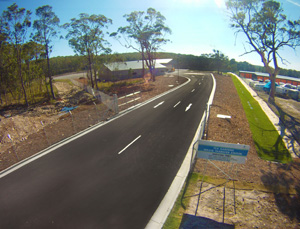Stuart Small, Projects and Contracts Engineer at Great Lakes Council, NSW, shares his experience using AUS-SPEC specifications for a recent $5.1 million project – the largest project the council has ever undertaken.
The project comprised of three main elements:
- An extension of the Tea Gardens Industrial Estate;
- A new Waste Transfer Station;
- The preparation of the new Works Depot site.
The project reached practical completion in November 2013 and “community uptake of the facility has been fantastic,” says Small.

Extension of the Tea Gardens Industrial Estate
This included the extension of one road, the construction of another and the creation of 12 industrial subdivision lots. Four lots were fully constructed and the remaining eight were partially constructed to enable the continued operation of the council’s existing Works Depot.
Associated works included the following:
- Construction of a large open stormwater drainage line;
- Construction of a vacuum sewerage system;
- Extension to the water reticulation supply;
- Extension to the electricity supply;
- Extension to the telecommunications network.
New Waste Transfer Station
This comprised the construction of a tip shop building, a large steel roof structure providing weather protection, a large concrete hard stand area, access and circulating roadways measuring roughly 350m long, and the necessary supporting infrastructure. The steel roof structure covers the concrete hardstand area and is 46.6m long x 19.6m wide, and is typically between five and six metres high and open on all sides.
Council subcontractors undertook bitumen sealing and asphalting on the project site under the direction and control of the contractor. Council supplied the nominated materials that it had readily available on contract.
Preparation for the new works depot site
The site works for the new works depot were limited to:
•
Clearing and grubbing the site;
•
Fencing the boundary;
•
Construction of utility connections to the nominated points.
Council experience of using AUS-SPEC
Small highlights the ease of using and sharing AUS-SPEC documents with the contractors and the time and money saved. He says he only had a fortnight to complete the specification and other tender documents and explains that although this was made up of long days, “it’s very quick and I would have been in there for months trying to write it from scratch”.
“The technical specification template is there and it’s so clear, there’s no ambiguity […]. On that particular job there was some variation in regards to the ground conditions which the technical specification could not cover,” Small says. This variation only accounted for approximately five per cent of the entire project, which he describes as “minimal”.
Small has been using AUS-SPEC since 2002. As a young engineer in western NSW he was given AUS-SPEC documents for a bridge tender. He describes it as “a big learning experience”.
“I didn’t know about the introduction into tenders and conditions of tendering, so having that documentation there, explaining the process and sitting down and reading through it and then putting it into application has really helped," he says. "I see a lot of other tenders go out and they don’t have those basic components and it’s something you can see yourself because the documentation is all there on your [NATSPEC] website with TECHguides, showing you how to do it."
AUS-SPEC has been developed for use throughout the industry as a uniform contract documenting system. It aims to promote a common working language between local councils and contractors as many contractors work with several different councils. “It’s not about reinventing the wheel,” Small says. “It’s about standardisation across the industry so a company or private enterprise knows what they’re going to get from each council”.
AUS-SPEC is the national local government specification for the lifecycle management of assets, founded on the collective wisdom of many local councils and with input from various industry organisations. AUS-SPEC standard contract documents have been developed specifically for local government works and contract management, reflecting the terminology and requirements of local government in Australia.
AUS-SPEC has been widely accepted for its clear language, structure and layout. Using a well-prepared specification system like AUS-SPEC, especially for tender documents, leads to consistency and efficiency across the industry. The system supports technical and contractual consistency between councils, while allowing flexibility to edit and add project-specific requirements where necessary. The development of standard processes through AUS-SPEC documentation allows efficient and effective management and upgrade of infrastructure assets.
For more information, visit www.natspec.com.au
In the picture: View of the entrance to the new Great Lakes Council waste transfer station